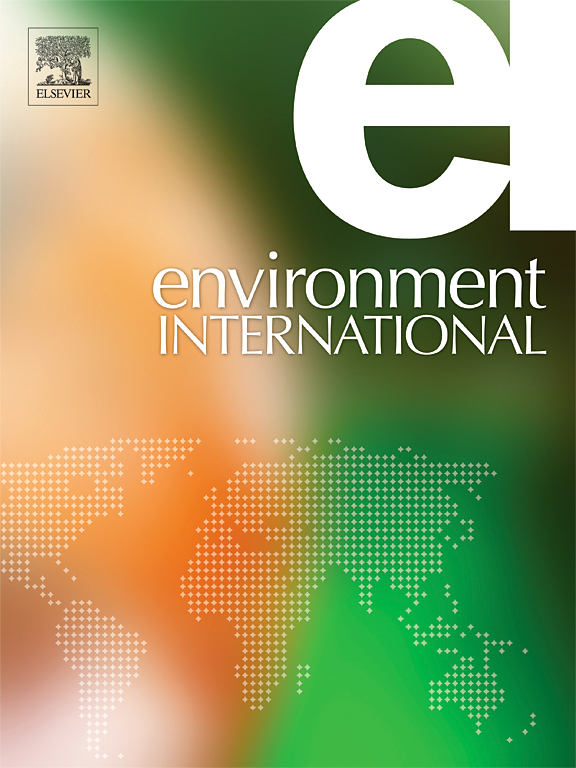Cresyl diphenyl phosphate (a novel organophosphate ester) induces hepatic steatosis by directly binding to liver X receptor α: From molecule action to risk assessment
IF 10.3
1区 环境科学与生态学
Q1 ENVIRONMENTAL SCIENCES
引用次数: 0
Abstract
Cresyl diphenyl phosphate (CDP), a novel organophosphate ester (OPE), has been increasingly detected in various environmental and human samples. However, its toxicity, mechanisms, and health risks remain largely unknown. In this work, we investigated CDP-induced hepatic steatosis through Liver X Receptor α (LXRα) pathway across the molecular interactions, signaling pathways, cell functions, animal effects, and population risks, and compared them to triphenyl phosphate (TPHP) and tricresyl phosphate (TCRP). Receptor binding results showed that all three OPEs bound to LXRα directly in the order of TCRP > CDP > TPHP. Docking results suggested that the three aryl groups played an essential role in the binding of these chemicals to LXRα. They also activated LXRα-mediated lipogenesis pathway and promoted lipid accumulation in HepG2 cells. The intracellular concentration and LXRα-bound concentration of the chemicals in HepG2 cells followed a consistent order of CDP > TCRP > TPHP. In mice, exposure to CDP activated LXRα-mediated de novo lipogenesis pathway, leading to hepatic steatosis. Risk assessment results suggested that few populations (5.38 %) face a LXRα-mediated hepatic steatosis risk from CDP exposure. Collectively, our results demonstrate that CDP could bind to LXRα, activate the subsequent de novo lipogenesis pathway, inducing hepatic steatosis, and increasing adverse health risks.磷酸甲酚二苯酯(一种新型有机磷酸酯)通过直接与肝 X 受体 α 结合诱导肝脂肪变性:从分子作用到风险评估
磷酸甲酚二苯酯(CDP)是一种新型有机磷酸酯(OPE),在各种环境和人体样本中的检出率越来越高。然而,它的毒性、机制和健康风险在很大程度上仍然未知。在这项工作中,我们研究了 CDP 通过肝 X 受体α(LXRα)通路诱导肝脂肪变性的分子相互作用、信号通路、细胞功能、动物效应和人群风险,并与磷酸三苯酯(TPHP)和磷酸三甲苯酯(TCRP)进行了比较。受体结合结果表明,三种OPE都能直接与LXRα结合,顺序依次为TCRP > CDP > TPHP。Docking 结果表明,三个芳基在这些化学物质与 LXRα 的结合过程中发挥了重要作用。它们还激活了 LXRα 介导的脂肪生成途径,并促进了 HepG2 细胞的脂质积累。这些化学物质在 HepG2 细胞中的细胞内浓度和 LXRα 结合浓度按照 CDP > TCRP > TPHP 的顺序排列。在小鼠体内,接触 CDP 会激活 LXRα 介导的新生脂肪生成途径,导致肝脏脂肪变性。风险评估结果表明,少数人群(5.38%)因接触 CDP 而面临 LXRα 介导的肝脂肪变性风险。总之,我们的研究结果表明,CDP 可与 LXRα 结合,激活随后的新生脂肪生成途径,诱发肝脂肪变性,增加不良健康风险。
本文章由计算机程序翻译,如有差异,请以英文原文为准。
求助全文
约1分钟内获得全文
求助全文
来源期刊

Environment International
环境科学-环境科学
CiteScore
21.90
自引率
3.40%
发文量
734
审稿时长
2.8 months
期刊介绍:
Environmental Health publishes manuscripts focusing on critical aspects of environmental and occupational medicine, including studies in toxicology and epidemiology, to illuminate the human health implications of exposure to environmental hazards. The journal adopts an open-access model and practices open peer review.
It caters to scientists and practitioners across all environmental science domains, directly or indirectly impacting human health and well-being. With a commitment to enhancing the prevention of environmentally-related health risks, Environmental Health serves as a public health journal for the community and scientists engaged in matters of public health significance concerning the environment.
 求助内容:
求助内容: 应助结果提醒方式:
应助结果提醒方式:


